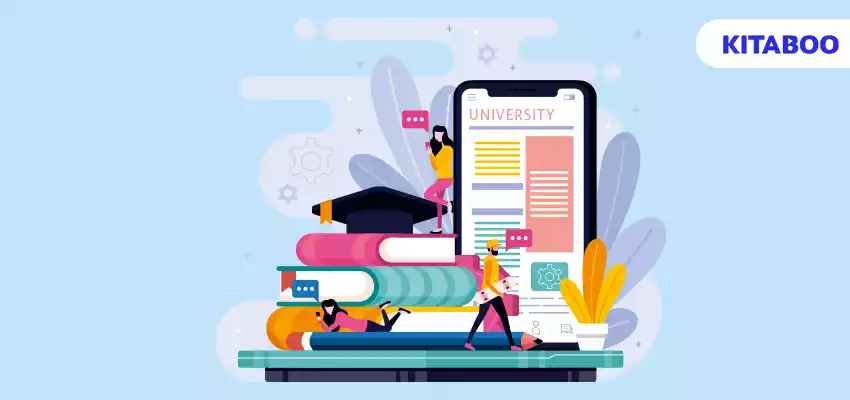
Navigating College Textbook Choices: Digital or Print?
The never-ending debate about choosing between printed textbooks and digital eBooks is still prevalent in higher education. One of the significant higher education textbook trends includes the adoption of eBooks and open educational resources (OER). However, the fact remains that students are still inclined to print traditional textbooks, which cannot be neglected.
This hybrid style of college textbook selection has a massive impact on learning experiences, student budgets, convenience and accessibility of students, and even sustainability.
Pivotal digital textbook platforms like KITABOO are adopting various measures to offer the best of both worlds. They are using formats like ePUB to convert PDF formats and traditional books into eBooks.
The aim is to offer both kinds of content to higher education learners, which offers immense portability, searchability, and interactive content. It is a fundamental trend, and we shall unravel the critical choice of both digital course materials and print textbooks.
Table of Contents:
I. Key Information on Print and Digital College Textbooks
II. What Makes Learners Stick to Print Learning Resources
IV. The Future of Learning and Higher Education Textbook Trends
V. Conclusion
Key Information on Print and Digital College Textbooks
Higher education textbook trends include innovative teaching-learning approaches, flipped classrooms, simulation-based teaching, and enhanced clinical learning.
- 95% of libraries started subscribing to eBooks in 2011.
- A recent research on 607 higher education students led to the following results:
- 74.6% of students preferred digital content because it is easier to carry, while 80.6% of students spent more than an hour using eBooks.
- On the other hand, 66.7% of college students preferred printed books as it was easier for them to make notes.
- Another study shows that 13% of colleges and universities have adopted digital transformation in student learning experiences, while 70% of them are still developing a strategy. Also, 91% of students opine that digital learning experiences are as vital as face-to-face lectures on campus.
Thus, it can be stated that print college textbooks have not been eradicated; however the demand and strong inclination towards digital course materials and content is increasing day-by-day.
What Makes Learners Stick to Print Learning Resources
No matter how popular digital learning is in K-12 learning and higher education environments, the relevance and scope of printed textbook learning cannot be neglected.
Here are some reasons why print learning content is still popular among college students:
- Uniformity in Deliverables: Printed content for college students is structured guides that systematically organize information. They cover all the necessary topics according to the curriculum and ensure uniformity in delivering knowledge to all students regardless of the learning institution or teacher.
- Offline-Availability: They are useful, especially when internet access is limited. For new educators, print textbooks serve as ready-made lesson plans, which further help them focus on teaching methods and student interaction.
- Expert Guidance: These are reliable resources written and reviewed by experts based on the latest research and teaching strategies.
- Accessibility: They align with educational standards. Printed content reduces screen time, offers a break from digital learning, and ensures accessibility to learning materials for all students.
Extra Features: Such content also develops important study skills such as note-taking and summarizing, which are valuable for both academic and professional life.
What Leads to the Transition from Print to Digital College Textbooks?
Here are some of the reasons why student learning is depending on digital course materials:
- Significant characteristics: Online content, eBooks, and OER usage are some of the key higher education textbook trends, as it is vast, diverse, portable, adaptable, updated, and offers significant features and features.
- Immersive and Engaging Content: OERs and eBooks are created with the basic addition of printed content plus multimedia elements, interactive assessments, real-world global examples, expert opinions, and immersive learning experiences.
- Easy Availability and Accessibility: The versatility and impact of digital content are also facilitated by its easy and free availability online, 24/7 accessibility on various devices in various formats, and knowledge-sharing capabilities among learners and educators.
- Cost-effective Solutions: One of the pivotal reasons why digital college textbooks have gained recognition is affordability. Print media is expensive and even leads to environmental concerns. On the contrary, digital course materials are easy on the pocket of students, enhance the monetization sources for publishers because of their global reach, and are also an eco-friendly option.
The Power of eLearning
eLearning has transformed traditional learning methods and offers efficient higher education solutions. Let us consider various features and benefits of digital student learning experiences and understand how eLearning has surpassed geographical barriers and time constraints.
1. The Emergence and Scope of Open Educational Resources OER
One of the most significant higher education textbook trends is the advent of OER. Open Educational Resources OER and digital textbooks offer a wide variety of educational content, which is freely accessible for educational use.
Students can engage with OERs to solve problems or conduct research. Even publishers can offer high-quality digital textbooks by adapting OER content into their digital content strategies.
2. Interactive Simulations for Education
Interactive Simulations, especially for college learning in Science, Technology, Engineering, and Math, provide virtual laboratories for conducting experiments. Several platforms offer peer-reviewed textbooks that cover various subjects, making quality education accessible to all learners.
3. Inclusion of Multimedia Learning
Platforms such as KITABOO provide audio content, 3D techniques, infographics, charts, diagrams, maps, video lectures, and animations catering to diverse learning styles. Such immersive content enriches higher education experiences with engaging content across subjects.
4. Diverse Formats
Digital content in college textbooks is available in diverse formats. This includes digital textbooks, lecture notes, research papers, and articles.
These books also include accessibility features like text-to-speech, voice-overs, multi-language translations, the use of gamification tools, quizzes, and interactive games to promote active learning.
5. Cost-Efficiency
Compared to traditional education, digital learning reduces the expenses associated and makes quality education more affordable and accessible. It transcends geographical boundaries and allows students from across the globe to acquire digital course materials at low costs offered by institutions worldwide.
6. Instant Feedback and Progress Tracking
Online assessments help higher education learners with immediate feedback on their performance. This further empowers educators and learners to identify individual strengths and areas for improvement, track progress, curate or update content according to demands and personalized requirements, and monitor learning advancement effectively.
7. Design Effectiveness
Another key feature is the user-friendliness, high-quality, and attractive designs of eBooks that attract the attention of readers and learners. The less linear nature of digital college textbooks helps students with various resources and elements that offer multiple ways to navigate through topics.
The Future of Learning and Higher Education Textbook Trends
Digital course materials are not a passing trend, and they are surely here to stay. In fact, as technology advances, the constant and consistent shift from print to digital is evident.
Students today, demand and prefer immersive and effective digital college textbooks. Further, the use of AI capabilities and cloud-based digital textbook platforms like KITABOO is transforming digital learning, and making higher education more immersive and interactive.
Authors and publishers are focusing on the provision of digital versions of print materials. There are clear signs that digital is being considered at higher rates than in the past. Content creators are promoting access to DRM-enriched, secure, lower-cost, and open learning resources. Further digital learning also incorporates a professional development opportunity with an emphasis on active learning.
Such a revolution in the availability and provision of digital learning content has transformed student support and pedagogical strategies.
Conclusion
eBook, OERs, and modern digital content are reshaping the higher education landscape, and publishers and content creators are making quality learning materials accessible to all.
Leading digital textbook platforms like KITABOO are empowering authors and publishers to adopt interactive simulations, multimedia content, and various resource types to cater to diverse learning preferences. Modern educational resources are well-aligned with eLearning which has revolutionized education, encouraged innovation, enhanced the world of knowledge, and upgraded learning and teaching skills.
To know more about the relevance of effectiveness, you must contact the experts and professionals at KITABOO!
Discover how a mobile-first training platform can help your organization.
Kitaboo is a cloud-based platform to create, deliver & track mobile-first interactive training content.






